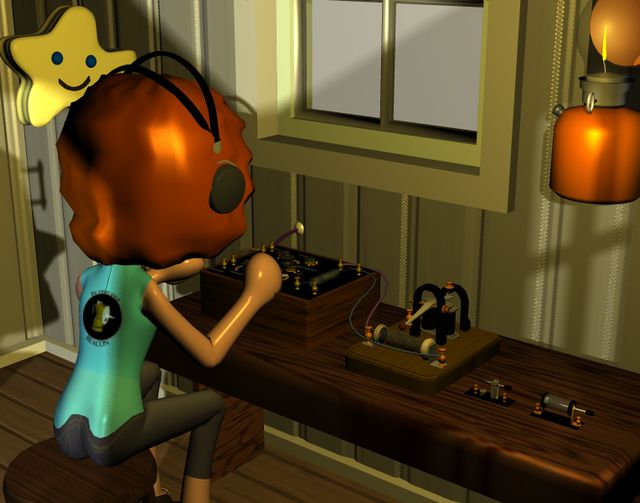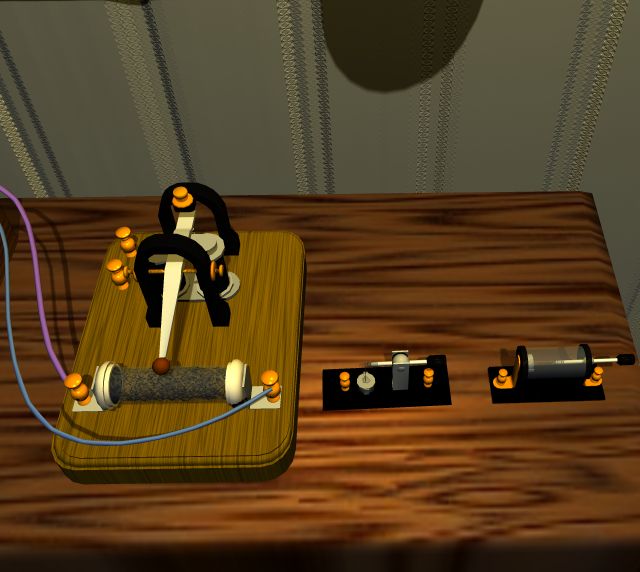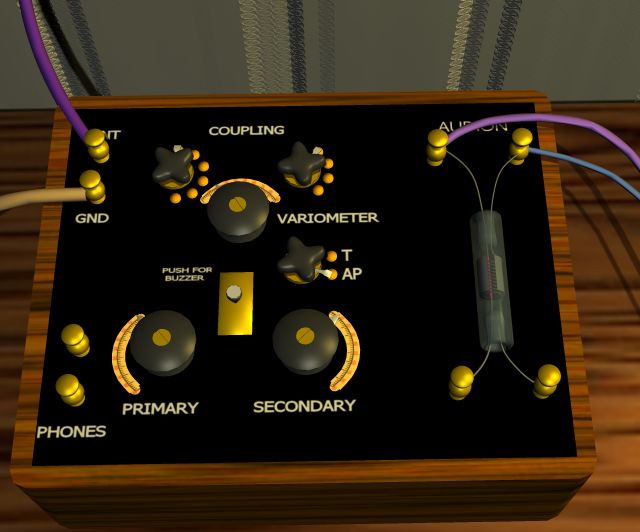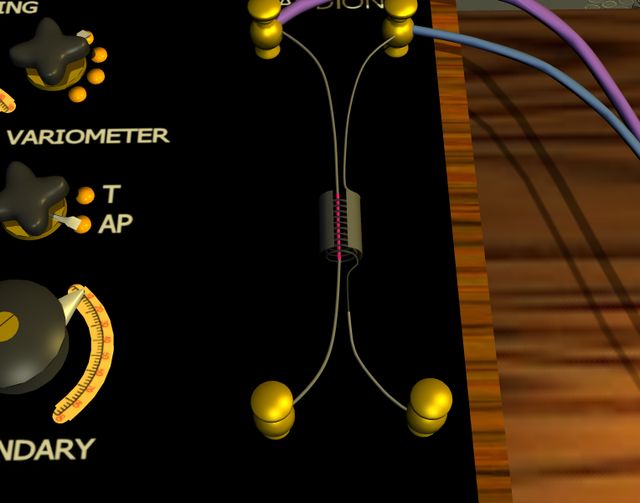Tuesday, November 10, 2020
Quickie on audions
I'm not doing justice to this subject but felt the need or duty to output SOMETHING with a bit of meaning, as counterforce to the wild destruction of logic and meaning. I might return later with a proper animation.
The first triode tube, DeForest's audion, looked a lot like the existing detectors for radio waves, and was used first as a detector plus incidental amplifier. Soon the audion's real use for amplification became clearer, and detection was separated from amplification.
Here Polistra is receiving Morse with an audion. I've shown a parallel connection to an external coherer to illustrate the substitution, but there wouldn't have been a real reason to connect them.
 Coherers were uniquely suited to spark gap transmitters. When spark gaps were gradually replaced by high-frequency alternators, then by tube oscillators, coherers were replaced by rectifiers. I'm showing two typical crystal rectifiers next to the coherer; first the common vertical catwhisker, then the enclosed horizontal version often used in military receivers.
Coherers were uniquely suited to spark gap transmitters. When spark gaps were gradually replaced by high-frequency alternators, then by tube oscillators, coherers were replaced by rectifiers. I'm showing two typical crystal rectifiers next to the coherer; first the common vertical catwhisker, then the enclosed horizontal version often used in military receivers.
 Closeup of the audion in action, connected to a receiver that tuned the incoming signal. The filament ran straight through from top to bottom; the grid was a sparse spiral around it; the plate surrounded the grid.
Closeup of the audion in action, connected to a receiver that tuned the incoming signal. The filament ran straight through from top to bottom; the grid was a sparse spiral around it; the plate surrounded the grid.
 Inner view without the glass. The action was similar to Lodge's precipitator. The hot filament threw off electrons. If the grid was uncharged, the electrons passed through to the positively charged plate easily. If the grid had a negative charge, it repelled the negative electrons and they stayed around the filament. The ability of a charge (without current) to regulate the flow of a large current is the valving or amplifying effect. Because the grid only varied the current when the charge on it was negative, it also rectified the incoming signal, giving rise to the demodulating or detecting effect.
Inner view without the glass. The action was similar to Lodge's precipitator. The hot filament threw off electrons. If the grid was uncharged, the electrons passed through to the positively charged plate easily. If the grid had a negative charge, it repelled the negative electrons and they stayed around the filament. The ability of a charge (without current) to regulate the flow of a large current is the valving or amplifying effect. Because the grid only varied the current when the charge on it was negative, it also rectified the incoming signal, giving rise to the demodulating or detecting effect.
 These earliest audions typically used 12 to 20 volts on the plate. Later submini tubes returned to this range of voltage, but by that time transistors were already underway. As I discussed earlier, if tubes had continued on this scale, it would have made experimentation much easier and safer, and it also would have made rechargeable batteries more practical. Wet batteries are necessarily big, and a wet battery for the typical 90 volt B supply would occupy a major piece of furniture. Dry batteries are wasteful of materials and short-lived, but 90 volts could be packed into a cardboard case about 6 inches long.
These earliest audions typically used 12 to 20 volts on the plate. Later submini tubes returned to this range of voltage, but by that time transistors were already underway. As I discussed earlier, if tubes had continued on this scale, it would have made experimentation much easier and safer, and it also would have made rechargeable batteries more practical. Wet batteries are necessarily big, and a wet battery for the typical 90 volt B supply would occupy a major piece of furniture. Dry batteries are wasteful of materials and short-lived, but 90 volts could be packed into a cardboard case about 6 inches long.
 Coherers were uniquely suited to spark gap transmitters. When spark gaps were gradually replaced by high-frequency alternators, then by tube oscillators, coherers were replaced by rectifiers. I'm showing two typical crystal rectifiers next to the coherer; first the common vertical catwhisker, then the enclosed horizontal version often used in military receivers.
Coherers were uniquely suited to spark gap transmitters. When spark gaps were gradually replaced by high-frequency alternators, then by tube oscillators, coherers were replaced by rectifiers. I'm showing two typical crystal rectifiers next to the coherer; first the common vertical catwhisker, then the enclosed horizontal version often used in military receivers.
 Closeup of the audion in action, connected to a receiver that tuned the incoming signal. The filament ran straight through from top to bottom; the grid was a sparse spiral around it; the plate surrounded the grid.
Closeup of the audion in action, connected to a receiver that tuned the incoming signal. The filament ran straight through from top to bottom; the grid was a sparse spiral around it; the plate surrounded the grid.
 Inner view without the glass. The action was similar to Lodge's precipitator. The hot filament threw off electrons. If the grid was uncharged, the electrons passed through to the positively charged plate easily. If the grid had a negative charge, it repelled the negative electrons and they stayed around the filament. The ability of a charge (without current) to regulate the flow of a large current is the valving or amplifying effect. Because the grid only varied the current when the charge on it was negative, it also rectified the incoming signal, giving rise to the demodulating or detecting effect.
Inner view without the glass. The action was similar to Lodge's precipitator. The hot filament threw off electrons. If the grid was uncharged, the electrons passed through to the positively charged plate easily. If the grid had a negative charge, it repelled the negative electrons and they stayed around the filament. The ability of a charge (without current) to regulate the flow of a large current is the valving or amplifying effect. Because the grid only varied the current when the charge on it was negative, it also rectified the incoming signal, giving rise to the demodulating or detecting effect.
 These earliest audions typically used 12 to 20 volts on the plate. Later submini tubes returned to this range of voltage, but by that time transistors were already underway. As I discussed earlier, if tubes had continued on this scale, it would have made experimentation much easier and safer, and it also would have made rechargeable batteries more practical. Wet batteries are necessarily big, and a wet battery for the typical 90 volt B supply would occupy a major piece of furniture. Dry batteries are wasteful of materials and short-lived, but 90 volts could be packed into a cardboard case about 6 inches long.
These earliest audions typically used 12 to 20 volts on the plate. Later submini tubes returned to this range of voltage, but by that time transistors were already underway. As I discussed earlier, if tubes had continued on this scale, it would have made experimentation much easier and safer, and it also would have made rechargeable batteries more practical. Wet batteries are necessarily big, and a wet battery for the typical 90 volt B supply would occupy a major piece of furniture. Dry batteries are wasteful of materials and short-lived, but 90 volts could be packed into a cardboard case about 6 inches long.Labels: From rights to duties, Lodge
